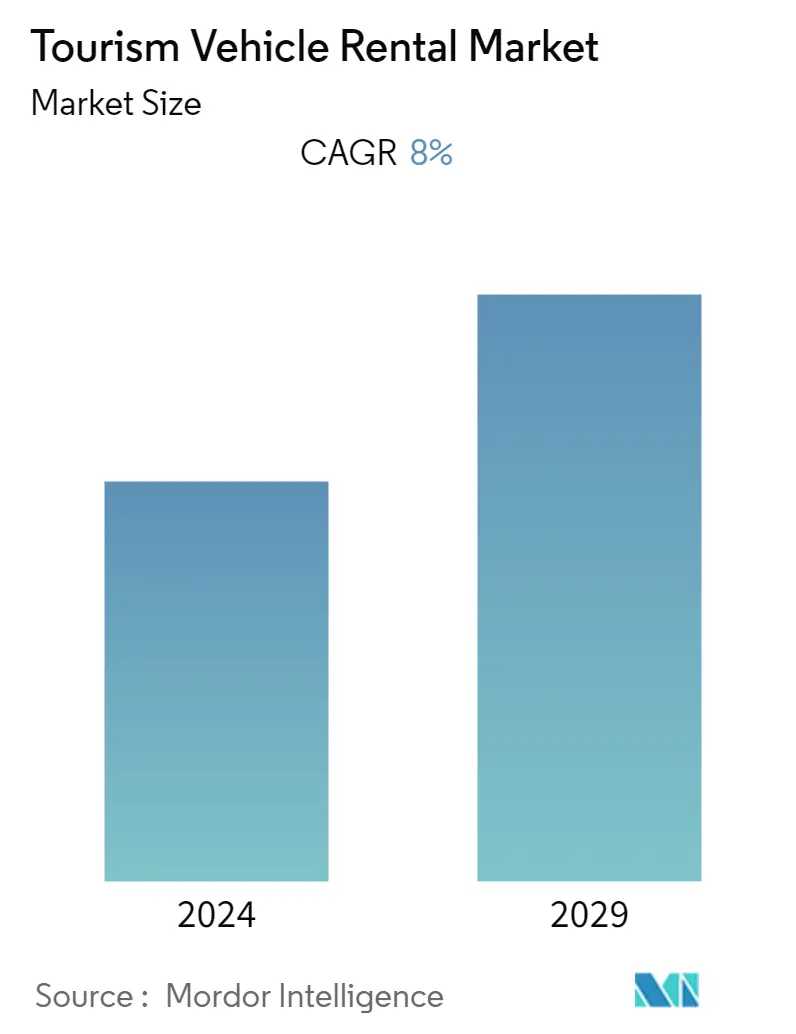Market Size of Tourism Vehicle Rental Industry

| Study Period | 2019 - 2029 |
| Base Year For Estimation | 2023 |
| CAGR | 8.00 % |
| Fastest Growing Market | Asia-Pacific |
| Largest Market | North America |
| Market Concentration | High |
Major Players
*Disclaimer: Major Players sorted in no particular order |
Tourism Vehicle Rental Market Analysis
The Tourism Vehicle Rental Market was valued at USD 61.28 billion in 2021 and is expected to reach USD 97.23 billion by 2027 registering a CAGR of around 8% during the forecast period (2022 - 2027).
The COVID-19 pandemic hindered the growth of the Tourism Rental Market as there were global factory shutdowns, travel bans, and border lockdowns, to combat and contain the outbreak, impacting every industry and economy worldwide. As tourism is a huge market, the demand for vehicle rentals halted with continuous lockdowns across the world.
However, as the unlocking process began restoring economic activities Tourism vehicle rental market is expected to witness nominal growth during the forecast period. People tend to prefer rental vehicles to any other means of transportation to maintain social distancing and hygiene protocols.
Other driving factors of the tourism vehicle rental market are, comfort, quality of life, freedom of moment, affordability, and low cost of traveling. The luxury vehicles segment will grow at the fastest pace during the forecast period owing to increased travel budgets of tourists around the world.
Region-wise, Asia-Pacific is one of the fastest-growing regional markets for tourism vehicle rental within the forecast period due to the growing population coupled with transportation issues in the region. Tourism vehicle rental service is very useful in Asian countries like India, Australia, Cambodia, Japan, China, etc. North America is expected to witness significant growth amid rising road trips by people during forecast period.
Tourism Vehicle Rental Industry Segmentation
A tourist rental vehicle means a self-propelled vehicle capable of being used for the temporary living, sleeping, or eating accommodation of persons on a rental basis for traveling and tourism purposes. The Tourism Vehicle Rental Market report covers the latest trends, and COVID-19 impact, followed by technological developments. The scope of the report covers segmentation based on Vehicle Type, End User, Booking Type, and Geography.
By Vehicle Type, the market is segmented into Economy and Luxury/Premium. By Booking Mode, the market is segmented as Online and Offline. By End User, the market is segmented into Self Driven and Rental Agencies.
By Geography, the market is segmented into North America, Europe, Asia-Pacific, and the Rest of the world. For each segment, the market sizing and forecast have been done on the basis of value (USD billion).
| Vehicle Type | |
| Economy | |
| Luxury/Premium |
| Booking Mode | |
| Online | |
| Offline |
| End User | |
| Self Driven | |
| Rental Agencies |
| Geography | |||||||||
| |||||||||
| |||||||||
| |||||||||
|
Tourism Vehicle Rental Market Size Summary
The tourism vehicle rental market is poised for significant growth in the coming years, driven by a resurgence in travel activities post-pandemic. The market, which experienced a downturn due to global travel restrictions and lockdowns, is now recovering as people increasingly prefer rental vehicles for their travel needs, prioritizing social distancing and hygiene. Factors such as comfort, affordability, and the freedom of movement are contributing to the market's expansion. The luxury vehicle segment is expected to grow rapidly, fueled by higher travel budgets. Regionally, Asia-Pacific is emerging as a fast-growing market due to its large population and transportation challenges, while North America is witnessing increased road trip activities. The market's growth is further supported by the rising trend of online bookings, facilitated by the increasing penetration of the internet and smartphones, which offer consumers detailed access to rental offerings.
The tourism vehicle rental market is characterized by a consolidated landscape dominated by major players like Enterprise Holdings, Hertz, Avis, Europcar, and Sixt SE. These companies are expanding their fleets and enhancing their service offerings to meet the growing demand. The market is also witnessing technological advancements, with online booking becoming the preferred choice for consumers, offering convenience and real-time monitoring of rental vehicles. The United States leads the market, with Canada and Europe also showing positive growth prospects. In Europe, the focus is on expanding fleets with low-emission vehicles, aligning with government regulations. The market's expansion is supported by strategic partnerships and acquisitions, as seen with companies like Volkswagen and Hertz, which are investing in electric vehicles and expanding their operations in new regions. Overall, the tourism vehicle rental market is set to grow steadily, driven by the recovery of travel activities and the increasing preference for rental services.
Tourism Vehicle Rental Market Size - Table of Contents
-
1. MARKET DYNAMICS
-
1.1 Market Drivers
-
1.2 Market Restraints
-
1.3 Industry Attractiveness - Porter's Five Forces Analysis
-
1.3.1 Bargaining Power of Suppliers
-
1.3.2 Bargaining Power of Consumers
-
1.3.3 Threat of New Entrants
-
1.3.4 Threat of Substitute Products
-
1.3.5 Intensity of Competitive Rivalry
-
-
-
2. MARKET SEGMENTATION (Market Size in Value USD billion)
-
2.1 Vehicle Type
-
2.1.1 Economy
-
2.1.2 Luxury/Premium
-
-
2.2 Booking Mode
-
2.2.1 Online
-
2.2.2 Offline
-
-
2.3 End User
-
2.3.1 Self Driven
-
2.3.2 Rental Agencies
-
-
2.4 Geography
-
2.4.1 North America
-
2.4.1.1 United states
-
2.4.1.2 Canada
-
2.4.1.3 Rest of North america
-
-
2.4.2 Europe
-
2.4.2.1 Germany
-
2.4.2.2 United Kingdom
-
2.4.2.3 France
-
2.4.2.4 Italy
-
2.4.2.5 Norway
-
2.4.2.6 Netherlands
-
2.4.2.7 Rest of Europe
-
-
2.4.3 Asia-Pacific
-
2.4.3.1 China
-
2.4.3.2 India
-
2.4.3.3 Japan
-
2.4.3.4 South Korea
-
2.4.3.5 Rest of Asia-Pacific
-
-
2.4.4 Rest of the World
-
2.4.4.1 South America
-
2.4.4.2 Middle-East and Africa
-
-
-
Tourism Vehicle Rental Market Size FAQs
What is the current Tourism Vehicle Rental Market size?
The Tourism Vehicle Rental Market is projected to register a CAGR of 8% during the forecast period (2024-2029)
Who are the key players in Tourism Vehicle Rental Market?
Avis, Enterprise, Europcar, The Hertz Corporation and Sixt SE are the major companies operating in the Tourism Vehicle Rental Market.

